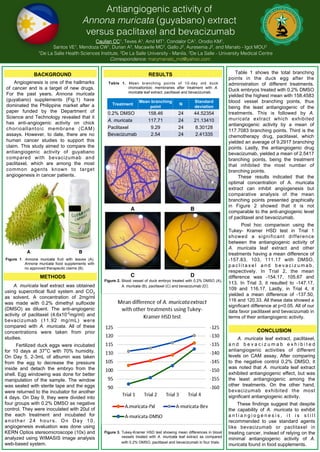Anti angiogenic activity of Annona muricata (guyabano) versus paclitaxel and bevacizumab
- 1. A. muricata leaf extract, paclitaxel, a n d b e v a c i z u m a b e x h i b i t e d antiangiogenic activities of different levels on CAM assay. After comparing to the negative control 0.2% DMSO, it was noted that A. muricata leaf extract exhibited antiangiogenic effect, but was the least antiangiogenic among the other treatments. On the other hand, bevacizumab exhibited the most significant antiangiogenic activity. These findings suggest that despite the capability of A. muricata to exhibit a n t i a n g i o g e n e s i s , i t i s s t i l l recommended to use standard agents like bevacizumab or paclitaxel in treating cancer, instead of relying on the minimal antiangiogenic activity of A. muricata found in food supplements. Angiogenesis is one of the hallmarks of cancer and is a target of new drugs. For the past years, Annona muricata (guyabano) supplements (Fig.1) have dominated the Philippine market after a paper funded by the Department of Science and Technology revealed that it has anti-angiogenic activity on chick chorioallantoic membrane (CAM) assays. However, to date, there are no human cancer studies to support this claim. This study aimed to compare the antiangiogenic activity of guyabano compared with bevacizumab and paclitaxel, which are among the most common agents known to target angiogenesis in cancer patients. A. muricata leaf extract was obtained using supercritical fluid system and CO2 as solvent. A concentration of 2mg/ml was made with 0.2% dimethyl sulfoxide (DMSO) as diluent. The anti-angiogenic activity of paclitaxel (4.6x10-2 mg/ml) and bevacizumab (11.92 mg/mL) were compared with A. muricata. All of these concentrations were taken from prior studies. Fertilized duck eggs were incubated for 10 days at 37┬░C with 70% humidity. On Day 5, 2-3mL of albumin was taken from the egg to decrease the pressure inside and detach the embryo from the shell. Egg windowing was done for better manipulation of the sample. The window was sealed with sterile tape and the eggs were returned to the incubator for another 4 days. On Day 9, they were divided into four groups with 0.2% DMSO as negative control. They were inoculated with 20ul of the each treatment and incubated for another 24 hours. On Day 10, angiogenesis evaluation was done using KERN Optios stereomicroscope (10x) and analyzed using WIMASIS image analysis web-based system. Antiangiogenic activity of ! Annona muricata (guyabano) extract versus paclitaxel and bevacizumab! 1De La Salle Health Sciences Institute, 2De La Salle University - Manila, 3De La Salle - University Medical Centre! Correspondence: marymanalo_md@yahoo.com! Table 1 shows the total branching points in the duck egg after the administration of different treatments. Duck embryos treated with 0.2% DMSO yielded the highest mean with 158.4583 blood vessel branching points, thus being the least antiangiogenic of the treatments. This is followed by A. muricata extract which exhibited antiangiogenic activity by a mean of 117.7083 branching points. Third is the chemotherapy drug, paclitaxel, which yielded an average of 9.2917 branching points. Lastly, the antiangiogenic drug bevacizumab, yielded a mean of 2.5417 branching points, being the treatment that inhibited the most number of branching points. These results indicated that the optimal concentration of A. muricata extract can inhibit angiogenesis but comparative analysis of the mean branching points presented graphically in Figure 2 showed that it is not comparable to the anti-angiogenic level of paclitaxel and bevacizumab. Post hoc comparison using the Tukey- Kramer HSD test in Trial 1 showed a significant difference between the antiangiogenic activity of A. muricata leaf extract and other treatments having a mean difference of -157.83, 103, 111.17 with DMSO, p a c l i t a x e l a n d b e v a c i z u m a b , respectively. In Trial 2, the mean difference was -154.17, 105.67 and 113. In Trial 3, it resulted to -147.17, 109 and 116.17. Lastly, in Trial 4, it yielded a mean difference of -137.50, 116 and 120.33. All these data showed a significant difference at p<0.05. All of our data favor paclitaxel and bevacizumab in terms of their antiangiogenic activity. Treatment Mean branching point N Standard deviation 0.2% DMSO 158.46 24 44.52354 A. muricata 117.71 24 21.13410 Paclitaxel 9.29 24 8.30128 Bevacizumab 2.54 24 2.41335 DC BA Figure 2. Blood vessel of duck embryo treated with 0.2% DMSO (A), A. muricata (B), paclitaxel (C) and bevacizumab (D).! Cauilan CC1, Teves A1, Amil MT1, Condalor CA1, Orodio KM1,! Santos VE1, Mendoza CW1, Durian A2, Macawile MC2, Gallo J2, Auresenia J2, and Manalo - Igot MOU3! BACKGROUND RESULTS METHODS A B Figure 1. Annona muricata fruit with leaves (A). Annona muricata food supplements with no approved therapeutic claims (B). Table 1. Mean branching points of 10-day old duck chorioallontoic membranes after treatment with A. muricata leaf extract, paclitaxel and bevacizumab.! CONCLUSION Figure 3. Tukey-Kramer HSD test showing mean differences in blood vessels treated with A. muricata leaf extract as compared with 0.2% DMSO, paclitaxel and bevacizumab in four trials.!

